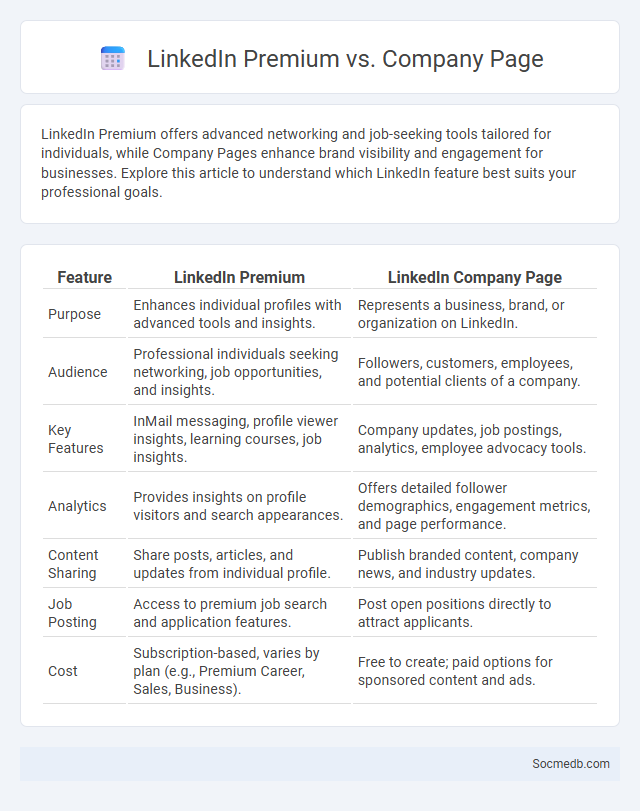
Photo illustration: LinkedIn Premium vs Company Page
LinkedIn Premium offers advanced networking and job-seeking tools tailored for individuals, while Company Pages enhance brand visibility and engagement for businesses. Explore this article to understand which LinkedIn feature best suits your professional goals.
Table of Comparison
| Feature | LinkedIn Premium | LinkedIn Company Page |
|---|---|---|
| Purpose | Enhances individual profiles with advanced tools and insights. | Represents a business, brand, or organization on LinkedIn. |
| Audience | Professional individuals seeking networking, job opportunities, and insights. | Followers, customers, employees, and potential clients of a company. |
| Key Features | InMail messaging, profile viewer insights, learning courses, job insights. | Company updates, job postings, analytics, employee advocacy tools. |
| Analytics | Provides insights on profile visitors and search appearances. | Offers detailed follower demographics, engagement metrics, and page performance. |
| Content Sharing | Share posts, articles, and updates from individual profile. | Publish branded content, company news, and industry updates. |
| Job Posting | Access to premium job search and application features. | Post open positions directly to attract applicants. |
| Cost | Subscription-based, varies by plan (e.g., Premium Career, Sales, Business). | Free to create; paid options for sponsored content and ads. |
Overview of LinkedIn Premium and Company Pages
LinkedIn Premium offers advanced networking tools, InMail credits, and detailed insights into profile viewers, enhancing your ability to connect with industry professionals and access exclusive job postings. Company Pages on LinkedIn serve as a platform for businesses to showcase their brand, share updates, and engage with followers through targeted content and analytics. Your strategic use of LinkedIn Premium combined with an optimized Company Page can significantly boost professional visibility and lead generation.
Key Features of LinkedIn Premium
LinkedIn Premium offers advanced features such as InMail messages allowing you to contact anyone outside your network, detailed insights on job postings, and access to LinkedIn Learning courses for skill development. The Premium Career plan highlights who viewed your profile and provides competitive insights against other applicants, enhancing your job search strategies. Your networking potential is maximized with access to exclusive insights and expanded search filters, making connections more targeted and efficient.
Key Features of LinkedIn Company Page
LinkedIn Company Pages offer key features such as detailed company descriptions, showcasing products and services, and sharing industry-relevant content to engage followers. The platform supports employee advocacy by highlighting team members and job postings, enhancing recruitment efforts. Advanced analytics provide insights into follower demographics and content performance, enabling data-driven marketing strategies.
LinkedIn Premium for Individuals: Pros and Cons
LinkedIn Premium for Individuals offers advanced features such as InMail messaging, detailed insights on who viewed your profile, and access to exclusive job listings, enhancing your networking and job search capabilities. The subscription can be costly, and some users may find the added features underutilized if they do not frequently engage with LinkedIn's tools. Carefully assessing your professional goals will help determine if LinkedIn Premium delivers sufficient value for your career development needs.
LinkedIn Company Page: Pros and Cons
Managing a LinkedIn Company Page boosts your brand visibility by connecting with professionals and showcasing industry expertise, leading to valuable networking and recruitment opportunities. However, maintaining an active presence requires consistent content creation and engagement to foster community growth, which can be time-consuming and resource-intensive. Your business can leverage LinkedIn's advanced analytics to refine marketing strategies, but competition for attention in a crowded professional space may limit organic reach without paid promotion.
Comparing Networking Capabilities
Social media platforms differ significantly in networking capabilities, with LinkedIn emphasizing professional connections and industry-specific networking, while Facebook and Instagram focus on personal relationships and community engagement. Twitter excels in real-time interaction and broad information sharing, making it ideal for news dissemination and influencer engagement. TikTok offers a unique algorithm-driven discovery process that fosters rapid content virality and audience growth through creative video networking.
Audience Reach and Engagement Differences
Social media platforms exhibit significant differences in audience reach and engagement, influenced by factors such as user demographics, content formats, and algorithmic preferences. Instagram tends to drive higher engagement rates through visual content, while Facebook offers broader audience reach across diverse age groups. Twitter excels in real-time interactions and trending topics, fostering immediate engagement but with a narrower reach compared to platforms like YouTube or TikTok.
Cost Analysis: Premium vs Company Page
Analyzing the cost of social media presence reveals that premium accounts often involve subscription fees ranging from $15 to $99 per month, offering advanced analytics, enhanced visibility, and advertising credits. In contrast, company pages on platforms like Facebook or LinkedIn are free to create but may incur significant costs when leveraging paid advertising or sponsored content to boost reach. Businesses must weigh ongoing premium subscription expenses against targeted ad spend to optimize ROI and achieve strategic marketing objectives.
Which Option Suits Your Business Goals?
Choosing the right social media platform depends on your business goals, target audience, and content strategy. For brand awareness, visually-driven platforms like Instagram and TikTok excel, while LinkedIn is more effective for B2B networking and lead generation. Analyzing platform demographics and engagement metrics ensures alignment with your marketing objectives and maximizes ROI.
Final Verdict: Choosing the Right LinkedIn Solution
Selecting the right LinkedIn solution depends on aligning platform features with specific professional goals, whether enhancing recruitment, sales, or networking capabilities. Advanced tools like LinkedIn Sales Navigator offer robust lead generation and market insights, while LinkedIn Recruiter specializes in talent acquisition efficiency. Evaluating budget constraints and integration needs ensures an optimized investment in LinkedIn's premium solutions for maximum ROI and strategic growth.
 socmedb.com
socmedb.com